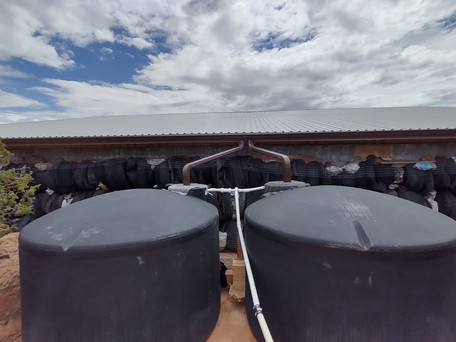Monsoon!
- Kimi BrownKawa
- Jul 31, 2021
- 3 min read
With our house newly roofed, we had 2600 square feet of metal sloped ominously toward our foundation. Our construction crew was done with their part. Now Chip and I had to prepare for the rains in a race between us and the upcoming monsoon!

Chip did the yeoman's work with pick and shovel to dig a drainage trench around the perimeter of the bales. I just helped dig out some of the soft dirt that had filtered back in. Then we both hauled gravel from the pile out front that had been sitting there since last fall, and put a layer in the bottom of the trench.
Then we brought our last drainage tube up. That tube has been sitting at the corner of our driveway since it arrived (along with 15 others) to build our geothermal greenhouse in 2019. We placed it in the trench, hauled and dumped the rest of the gravel, and filled in the top of the trench with dirt. We did leave exposed gravel at the back of the house where we will eventually build a berm up against the house.
With the drainage taken care of, we still had to connect the roof with the rainwater tanks. We had rain in the forecast, and found TG Orr Enterprises in Gallup, who could get out within the week and install a one-piece seamless gutter, with downspouts into our tanks. We jumped at that, and it went up, easy as could be! We also had to install the shut-off valves at the bottom of the tank so we'd have a way to plumb the house intake.
It was exciting to see that first little five-minute rain running into the tanks just a couple days later.
With the water drainage taken care of, we could enjoy our favorite season without being in a panic. The monsoon is lovely with warm days, afternoon storms, and cool evenings. I love cozying up in flannel jammies on July evenings! So far this year the mud hasn't gotten too bad. This time of year the desert plants are so aromatic, and the skies provide unending drama. Here are some examples of the changing mood...
It's hard finding good weather data out here where reporting stations are few and far between, and weather is hyper local. The continental divide is just a few miles away, and with all of the mesas and canyons, and wind coming from any direction, you never know what to expect. Before we moved out here we found that "Prewitt" averages 10-11" of rain each ear, but we don't know where they are even measuring from, since Prewitt covers 160 square miles but doesn't have a town center. We've had an electronic rain gauge for over a year now, and it said we got a grand total of five inches last year. This year we heard of CoCoRahs -- an organization that gathers daily rain data from citizens and makes it easy to compare precipitation differences neighborhood to neighborhood.
We got our analog CoCoRahs rain gauge (the National Weather Service considers them more reliable than electronic gauges), and have been reporting our precipitation since mid-June. The analog gauge consistently reads higher than our electronic gauge. This July we got either .47 or 1.37 inches total, depending on which gauge you believe!
When we've gotten big rains we go tap on the tanks to see how it's going. They are filling up! The other day it got high enough that we could see the level through the upper opening. That means a couple hundred gallons to go, but we needed to plumb the overflow before the next big rain! We did want to let the tanks fill up to make sure the overflow will work properly, but after that we'll start using our rain water for our daily use. (We have been hauling water from our neighbor's well.)
We have 3100 gallons capacity in these two tanks. At our currant consumption level that's about 6 months' worth of water! Of course once we are in a house we will probably shower once in a while, and even do laundry... hah!
Now we are just pleased that we won the monsoon race. In the nick of time...













































































































Awesome pictures! Progress is very exciting!
You're moving gravel with buckets? Must be nice to be young. I'd use a front-loader.
Last night's .17" put us over the top, literally... our overflow works! Now to start using rainwater... we will pull from one tank so that we can test whether excess water in the other tank flows into the emptier one before hitting the overflow as we hope.